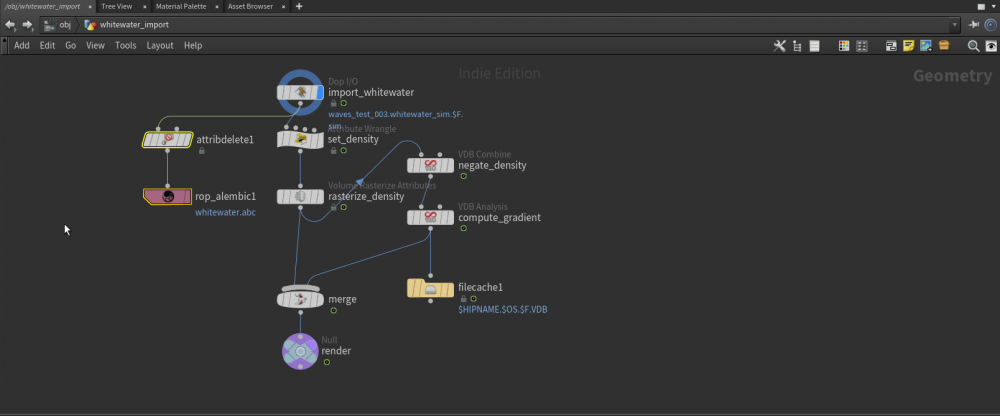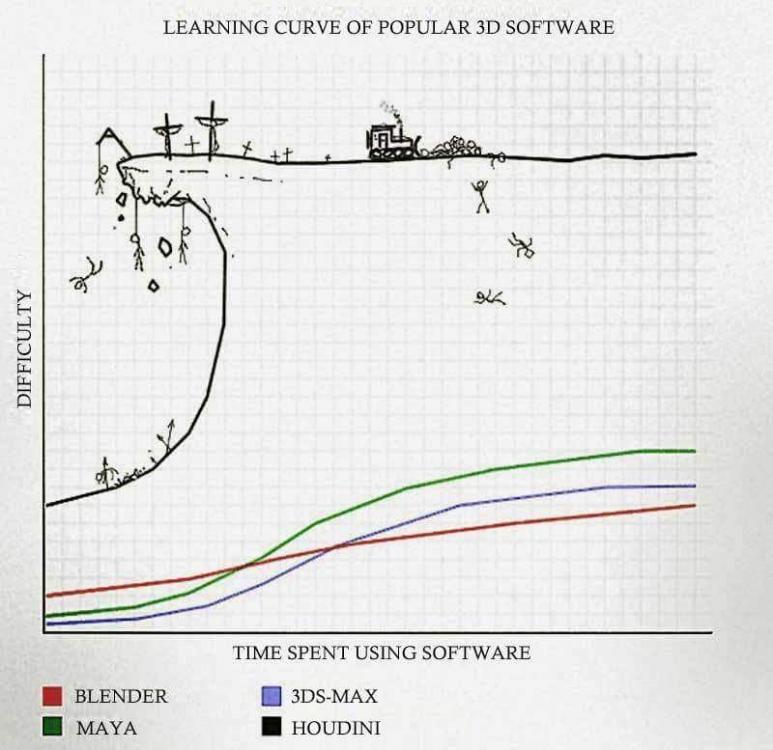Search the Community
Showing results for tags 'blender'.
-
Hi everyone! I am doing a fluid simulation in houdini that I then want to export in blender. I already achieved something, but I think I am in need of a couple of advices and I hope someone can help me here. This is the result so far after I exported all the elements in blender: VA_WaveTest_Houdini_002.mp4 Question1: how do I export whitewater separating spray from the foam and the bubbles? I am exporting whitewater using alembic to blender and it works great... However at the moment it's all in the same file, foam, bubbles and spray. While the former two I think can be rendered together, I would like to have the spray on a separate alembic or even better VDB so I can render it as a volume. How can I do so? Here you can see my current setup... I see that in the whitewater_IMPORT node group houdini extract some volume info from the whitewater particles so I tried to export those as a VDB but once I imported in blender I think that ALL the whitewater has been exported in the VDB not only the spray. I guess I would have to isolate some part of the whitewater based on some attribute, but I am a bit lost here... Can anyone give me a hand please? Question2: Is there a way to automate all the steps of the simulation caching process? So far I've been doing R&D but when the time for the final simulation come I would like to automate a bit the baking process. At the moment I cache in sequence: flip sim, whitewater sim, mesh and then I export the mesh and the white water to VDB. I would like to know if I can create some kind of BATCH of those actions so that I can leave the computer to crunch overnight and it will automatically start the next step after finishing baking the previous one. Thanks everyone for any help in advance!
-
Hey guys I built something similar like the Unreal pixel depth offset dithering or one recent blender addon here, with customs breakup noise and ramp falloff. SOP --> wrangle in COP and back to SOP. But i lack the dynamic option since i have to specify the input to blend with, i guess i have to use python to have this input change dynamically for this and for now, im only blending 2 inputs at a time. Obviously your ground can be made of many objects, with lots of other ones blending into then Obviously, your ground can be made of many objects, with lots of other ones blending into them—assets just can’t straddle two objects and blend with both. Is it possible to make this blend dynamic? Sidefx, sorry to say but i have a lot of issue when injecting COP to SOP, to have my viewport been updated. Render is fine but viewport no. Is there a way to force the update? Is there a way to collect in an array all geo around a certain radius distance for the asset and compute the blending value according, so with more than two assets? Even if its usally what you need... Cheers ________________________________________________________________ Vincent Thomas (VFX and Art since 1998) Senior Env and Lighting artist & Houdini generalist & Creative Concepts http://fr.linkedin.com/in/vincentthomas EhgzrVWXsAApdHB.mp4 M0-GeKTcr-tp9APD.mp4
-
- unreal pixel depth offset dithering
- unreal
- (and 4 more)
-
Good morning ODFROCE, I come from Blender so I am quite new in Houdini. There is this tool within Blender´s "tissue" addon called "Object: Area", which sort of calculates object weights depending on its volume. This comes very handy when dealing with particles, instances... I am sure Houdini has something similar but I havent been able to find it. I would appreciate if someone could show me the way. Thank you very much!!! zebra.
-
- 11 replies
-
- 10
-

-

-
Hey everyone, I just released my Pipeline called Prism, which I developed over the last few years. Prism is an artist-friendly Pipeline, mainly for animation and VFX projects, but it can help anyone who works within the CG industry. Prism does not only manage your scenefiles, exports and imports, but it also takes care of your playblasts, renderings and more. Prism works with many industry standard tools out of the box. This includes Houdini, Maya, 3ds Max, Blender and Nuke. And finally, Prism is free to use! Here is a short introduction video of Prism: https://vimeo.com/265003976 You can download it for free on the website: https://prism-pipeline.com/
-
This connector is written in Python with Node based Houdini workflow. It uses a wavefront OBJ and MDD cache. Transformation is described by quaternion rotation and is not tied to a parent (in world coordinates). These tools are designed to facilitate the export from Houdini. bl_tools.otl
-
I am mainly a blender users. I would like to start using Houdini. It's procedural and non-destructive workflow is very appealing to me. For my first day in Houdini I would like to re-create something procedural I did in blender using modifiers. I have a piece of tiling geometry, it is a section of a stone wall. I would like to array this wall along a curve. Also I would like to project the curve onto a piece of terrain. I am not expecting anyone to solve this problem for me. But I wouldn't mind some hints on how to approach this problem.



.png.f452e247417590c1fbbad580ee5a5185.png)
.png.76cff92b39e3cb6f6628ed2741ef61ef.png)
.png.971ee3d42b23c09666cea6aa0cd01a81.png)



